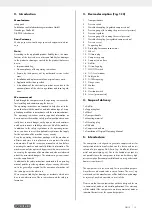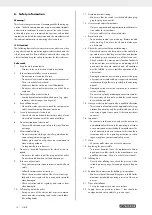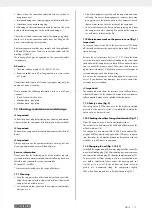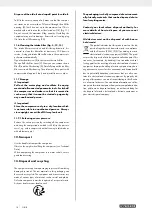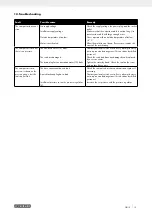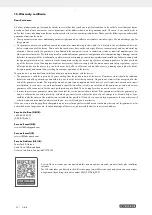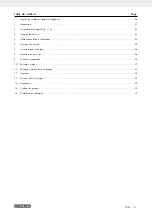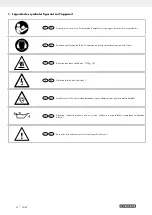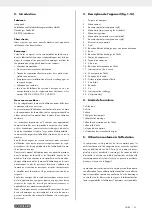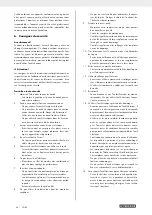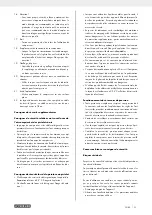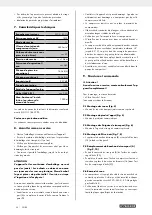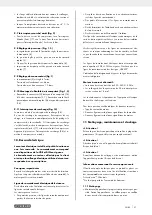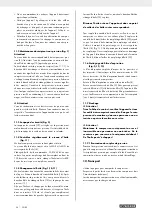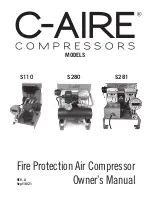
14
GB/IE
6. Safety information
Warning!
This electric tool generates an electromagnetic field during op-
eration. This field can impair active or passive medical implants
under certain conditions. In order to prevent the risk of serious
or deadly injuries, we recommend that persons with medical
implants consult with their physician and the manufacturer of
the medical implant prior to operating the electric tool.
m
Attention!
The following basic safety measures must be observed when
using electric tools for protection against electric shock, and the
risk of injury and fire. Read all these notices before using the
electric tool and keep the safety instructions for later reference.
Safe work
1. Keep the work area orderly
-
Disorder in the work area can lead to accidents.
2. Take environmental influences into account
-
Do not expose electric tools to rain.
-
Do not use electric tools in a damp or wet environment.
There is a risk of electric shock!
-
Make sure that the work area is well-illuminated.
-
Do not use electric tools where there is a risk of fire or
explosion.
3. Protect yourself from electric shock
-
Avoid physical contact with earthed parts (e.g. pipes,
radiators, electric ranges, cooling units).
4. Keep children away!
-
Do not allow other persons to touch the equipment or
cable, keep them away from your work area.
5. Securely store unused electric tools
-
Unused electric tools should be stored in a dry, elevat-
ed or closed location out of the reach of children.
6. Do not overload your electric tool
-
They work better and more safely in the specified out-
put range.
7. Wear suitable clothing
-
Do not wear wide clothing or jewellery, which can be-
come entangled in moving parts.
-
Rubber gloves and non-slip shoes are recommended
when working outdoors.
-
Tie long hair back in a hair net.
8. Do not use the cable for purposes for which it is not in-
tended
-
Do not use the cable to pull the plug out of the outlet.
Protect the cable from heat, oil and sharp edges.
9. Take care of your tools
-
Keep your compressor clean in order to work well and
safely.
-
Follow the maintenance instructions.
-
Check the connection cable of the electric tool regu-
larly and have it replaced by a recognised specialist
when damaged.
-
Check extension cables regularly and replace them
when damaged.
10. Pull the plug out of the outlet
-
During non-use of the electric tool or prior to mainte-
nance and when replacing tools such as saw blades,
bits, milling heads.
11. Avoid inadvertent starting
-
Make sure that the switch is switched off when plug-
ging the plug into an outlet.
12. Use extension cables for outdoors
-
Only use approved and appropriately identified exten-
sion cables for use outdoors.
-
Only use cable reels in the unrolled state.
13. Remain attentive
-
Pay attention to what you are doing. Remain sensible
when working. Do not use the electric tool when you
are distracted.
14. Check the electric tool for potential damage
-
Protective devices and other parts must be carefully in-
spected to ensure that they are fault-free and function
as intended prior to continued use of the electric tool.
-
Check whether the moving parts function faultlessly
and do not jam or whether parts are damaged. All
parts must be correctly mounted and all conditions
must be fulfilled to ensure fault-free operation of the
electric tool.
-
Damaged protective devices and parts must be prop-
erly repaired or replaced by a recognised workshop,
insofar as nothing different is specified in the operating
manual.
-
Damaged switches must be replaced at a customer
service workshop.
-
Do not use any faulty or damaged connection cables.
-
Do not use any electric tool on which the switch cannot
be switched on and off.
15. Have your electric tool repaired by a qualified electrician
-
This electric tool conforms to the applicable safety reg-
ulations. Repairs may only be performed by an electri-
cian using original spare parts. Otherwise accidents
can occur.
16. Important!
-
For your own safety you must only use the accessories
and additional units listed in the operating instructions
or recommended or specified by the manufacturer. The
use of mounted tools or accessories other than those
recommended in the operating instructions or cata-
logue may place your personal safety at risk.
17. Noise
-
Wear ear muffs when you use the compressor.
18. Replacing the power cable
-
To prevent hazards, leave the replacement of dam-
aged power cables strictly to the manufacturer or a
qualified electrician. There is a risk of electric shock!
19. Inflating tires
-
Directly after inflating tires, check the pressure with a
suitable pressure gauge, for example at your filling sta-
tion.
20. Roadworthy compressors for building site operations
-
Make sure that all lines and fittings are suitable for the
maximum permissible operating pressure of the com-
pressor.
21. Place of installation
-
Set up the compressor on an even surface.
22. Supply hoses at pressures above 7 bar should be
equipped with a safety cable (e.g. a wire rope).
Summary of Contents for 327366 1904
Page 4: ...10 11 7 12 13 8 9 B A D E C C D F 15 max min 18 16 20 14 24 G 6 1 25 1 25 13 ...
Page 75: ...71 ...
Page 77: ......
Page 79: ......














